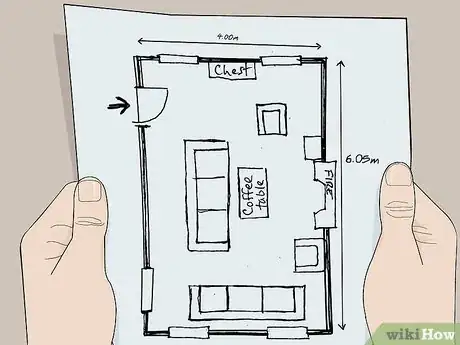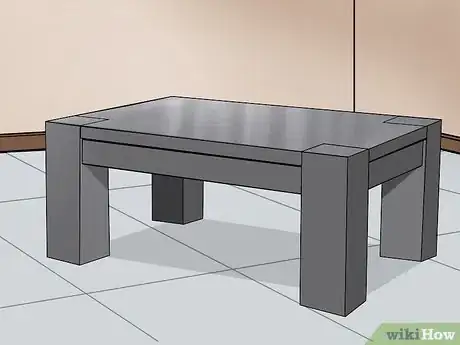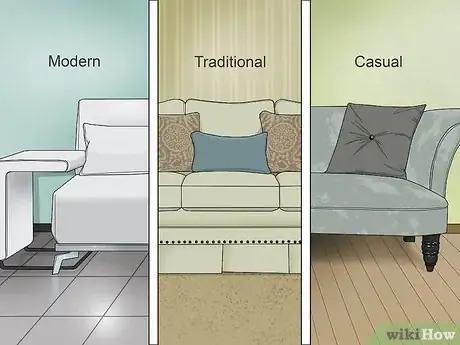This article was co-authored by Kanika Khurana. Kanika Khurana is an Interior Designer and the Owner of Kanika Design. With over 12 years of experience, Kanika specializes in remodeling, refurnishing, and color consulting. Kanika holds a Bachelor’s Degree in Psychology from San Francisco State University, a Redesign and Home Staging Certification, and an Associate Degree in Business Administration from Cañada College.
This article has been viewed 144,692 times.
Whether living on your own or with a family, your living room is an important space. This room is where your family spends time together, and it is the room most of your guests will spend the majority of their time in. Choosing furniture that creates a pleasant, welcoming appearance while holding up against the wear and tear of everyday life is the key in getting this space to work for your needs.
Steps
Making Plans
-
1Take measurements. Use a tape measure, yardstick, or meter stick to measure the length and width of your room. Also account for the dimensions of any alcoves or other recessed spaces in the room.[1]
-
2Create a floor plan. You can use formal grid paper, but you can also sketch it out on notebook paper or plain printer paper. Determine how much space you can spare for furniture and sketch out a few different ways that furniture can fit into the room. You should also factor in at least one yard (1 meter) of free space in between pieces of furniture. Anything smaller than that will make you feel as though you have to squeeze in between your furniture as you walk.[2]Advertisement
-
3Check your doorways. Measure how wide your doorways are to prevent potential delivery mishaps. You do not want to purchase a piece of furniture only to discover that you cannot get it into your house.
-
4Stage your living room. After determining how much space you can spare for furniture and where you want potential pieces to go, mark those spaces on the floor to get a better visual. Use painter's tape or spread out sheets of newspaper.
-
5Think about how the room will be used. If your living room will act as a daily family hangout, you will need sturdy, stain-resistant furniture, especially if your kids are still young. On the other hand, if your living room will only entertain the occasional guest, you can opt for more fragile pieces made with delicate fabrics.[3]
-
6Note the room's natural architecture. Some rooms contain built-in design elements that may help you determine the type of furniture that will look best inside the room. For instance, if you have a rustic fireplace, cabin décor may be a better option than stark modern furniture. Modern furniture may be the best option for a living room of an apartment with a view overlooking the city, however.
Picking Pieces
-
1Start with the basics. Most living rooms contain a sofa, armchair, side table, and coffee table. Look for these basic elements before adding extra pieces such as ottomans and additional tables.
-
2Buy investment pieces. Look for solid furniture with sturdy wood frames and sinuous steel springs. High-quality pieces may cost a little more, but they tend to hold up better and last longer.[4]
-
3Look for high-quality, stain-resistant fabrics. Luxurious, high-quality materials will keep you feeling more comfortable and tend to last longer than cheaper fabrics. Stain-resistant fabrics are especially useful if you have young children, but they might still be a good idea even if you only plan on using the space for guests since spills and stains can happen to anyone.[5]
- On top of being stylish, look for pieces of furniture that are comfortable to sit in. The last thing you want is to move your furniture in and have it be uncomfortable.[6]
-
4Look for cushions made of wrapped foam. Foam is comfortable and durable. Some cushions may be filled with down, but down usually breaks and wears quickly.[7]
-
5Test the strength of the frame. Lift one leg of the piece about six inches (15 centimeters) off the floor. If the adjacent leg has not risen as well, the frame is too flexible and too flimsy.
-
6Coordinate your pieces. Each piece of furniture in your living room should complement the others. Otherwise, your room will look chaotic and thrown together. If you have an interior design theme, such as modern or traditional, stick with pieces that fit with your theme.
-
7Know your themes. There are a number of ways to divide up interior design themes, but the main ones often include modern, contemporary, traditional, casual, and Old World.
- Modern and contemporary furniture has sleek, clean lines and usually makes use of white, beige, or other neutral colors. Glass, metal, and shiny black lacquer are used more often than traditional woods.
- Traditional furniture is elegant. It tends to look a little more formal and may include details like rolled arms and skirted bottoms. Colors range from ivory to rich hues of red and other colors.
- Casual furniture is friendly and cozy. Many pieces make use of plaid, small prints, and other patterns.
- Old World furniture combines styles from French, Spanish, and Italian designs. Rustic, antique pieces are especially appropriate, and you should look for deep, earthy colors.
-
8Opt for a loveseat instead of a sofa if you have a smaller space. Loveseats typically provide seating for two individuals. If you have a small family or only intend to use the space for entertaining an occasional guest, a loveseat could save you space while providing you with as much as you need.
-
9Fill the room in with additional pieces as space allows. Chests, flat-top ottomans, and extra tables or seating can add a lot to a large living room, but too many of these pieces will crowd out a smaller space.
Expert Q&A
-
QuestionHow do I pick what sofa to get for my living room?
 Kanika KhuranaKanika Khurana is an Interior Designer and the Owner of Kanika Design. With over 12 years of experience, Kanika specializes in remodeling, refurnishing, and color consulting. Kanika holds a Bachelor’s Degree in Psychology from San Francisco State University, a Redesign and Home Staging Certification, and an Associate Degree in Business Administration from Cañada College.
Kanika KhuranaKanika Khurana is an Interior Designer and the Owner of Kanika Design. With over 12 years of experience, Kanika specializes in remodeling, refurnishing, and color consulting. Kanika holds a Bachelor’s Degree in Psychology from San Francisco State University, a Redesign and Home Staging Certification, and an Associate Degree in Business Administration from Cañada College.
Interior Designer Choose a piece of furniture that's functional with your space. Whatever you pick, make sure you test it out first to make sure it's comfortable.
Choose a piece of furniture that's functional with your space. Whatever you pick, make sure you test it out first to make sure it's comfortable. -
QuestionWhat are some cat friendly fabrics?
 Community AnswerI have a microfiber couch, and it is terrific. It does not trap fur, and if your cat kneads it, it is very durable.
Community AnswerI have a microfiber couch, and it is terrific. It does not trap fur, and if your cat kneads it, it is very durable. -
QuestionHow should I set up my sofa in a long, narrow room?
 Steve JonesCommunity AnswerYou can just set up your sofa in front of your wall. This is the best place for it because you can save space with it.
Steve JonesCommunity AnswerYou can just set up your sofa in front of your wall. This is the best place for it because you can save space with it.
Things You'll Need
- Tape measure
- yardstick
- Grid paper
- Scratch pad
- Pencil
- Painter's tape
- Newspaper
- Couch
- Loveseat
- Armchairs
- End tables
- Coffee table
- Ottoman
References
- ↑ https://homedesignlover.com/home-furniture/tips-in-choosing-living-room-furniture/
- ↑ https://homedesignlover.com/home-furniture/tips-in-choosing-living-room-furniture/
- ↑ https://homedesignlover.com/living-room-designs/living-room-furniture-tips/
- ↑ https://www.homeadvisor.com/r/living-room-furniture/
- ↑ https://www.housebeautiful.com/uk/decorate/living-room/a85/buy-sofa/
- ↑ Kanika Khurana. Interior Designer.
- ↑ https://www.housebeautiful.com/uk/decorate/living-room/a85/buy-sofa/
- Home Design Lover: How to Choose Apt Living Room Furniture
About This Article
Before choosing living room furniture, measure the dimensions in your living room. Once you have measurements, pick out your essential furniture first, like your sofa, loveseat, and coffee table, making sure that your pieces will fit well your living room. Choose modern pieces of furniture, which have clean lines and neutral colors, or choose traditional pieces, which are more formal and tend to be in cool tones, like blues and grays. For more about testing your furniture's durability and whether to choose stain-resistant fabrics, keep reading!

































































